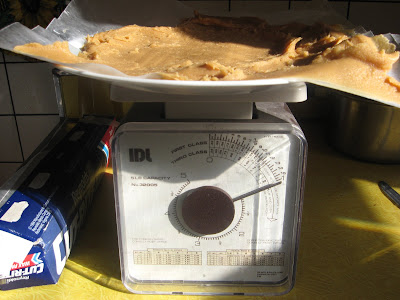

After smoking the entrances and staying ahead to give the bees time to become sedated, I take off the lid to make it easier to lift the upper hive body of the brood chamber from the lower one. Once the lid is off I separate the two hive bodies and puff some more smoke between them before lifting the upper hive body off. I find the bees remain more calm this way and I rarely use smoke under the outer or inner lid like I have seen some people do. I might use a little smoke when adding a honey super but I mainly do it to sedate the bees between the inner and outer covers before removing the outer cover.

After removing the upper hive body of the brood chamber I could see the remnants of a sugar cake that added to the colony a while back. A really friendly beekeeper in Washington state gave me a recipe for the cakes. The colony didn't really need the cake but I needed an excuse to open the hive.
After opening the hive down to the cluster area I decided to examine the the frames for brood. It had been a weeks (maybe three?) since I looked for any brood or eggs and this time I found some! The bees are not bringing in pollen yet so they are using last years reserves to begin brood rearing. It looks as if I intervened at the opportune moment. If you click on the picture to enlarge it you can see eggs in the cells adjacent to the capped brood. The frames beside this frame have a similar brood area. The bees are rearing brood closest to the center of where they cluster in order to keep the pupae at the proper incubation temperature and to avoid chilled brood.

The next picture has the queen in the midst of the workers. She is on some natural comb from a colony which I extracted last May. I can easily tell that the comb was from the cut-out because it is in a swarm catch frame.

After looking at the frames it was time to place the pollen patty. When placing the pollen patty be sure that all bee are off of the top bars. You can do this by gently smoking the bees or by lightly brushing them. After the top bars are clear of bees scrape off any comb that may be on the top bars before placing the pollen patty.


After the pollen patty is in position the upper hive body must be put back into place. Be sure to look at the bottom bars of the frames to ensure that there is no bees that will be squashed into the pollen patty. If there are bees there smoke them off and scrape away any burr comb that may be on the bottom bars.

Here's a picture of the top hive body back atop the lower hive body. This hive body is still full of honey and heavy. I doubt if I will need to feed this colony syrup. The only syrup this colony will most likely be getting is from stimulative communal syrup feeders.

Here's another colony with a pollen patty added.

Here I am clearing a seat for another patty.

Once the way is clear the patty is put into place.

Around an hour after placing the patties within the colonies I could see a big difference in the behavior of the hives. All the colonies were abuzz with action. Pollen patties encourages the foraging of honeybees as well as brood rearing.

It was really neat to see the increase in activity outside of the hives. It has been warmer here today in the past few weeks than it was today and the colonies exhibited much less activity. Though I monitored the entrances for bees returning to their homes I never did see one bee return with pollen. I believe it is a good thing that I gave them each a pollen patty since they are raising brood and do not have a source for pollen as of yet.
I surely hope that you enjoyed this post to my blog. This time of year it seems that there is always a lot of chatter about feeding pollen patties as everyone wants their colonies to start raising a lot of brood. Now instead of talking a big game I just go ahead and do what I want or need to do. I didn't need to add the patties but I wanted to help ensure healthy populations in a few months so I can start making nucs and raising queens. Thanks for reading the post and stay tuned because there is more to come.












